|
June Article
|
Helping Hummingbirds
You're sitting in your yard and suddenly out of nowhere -
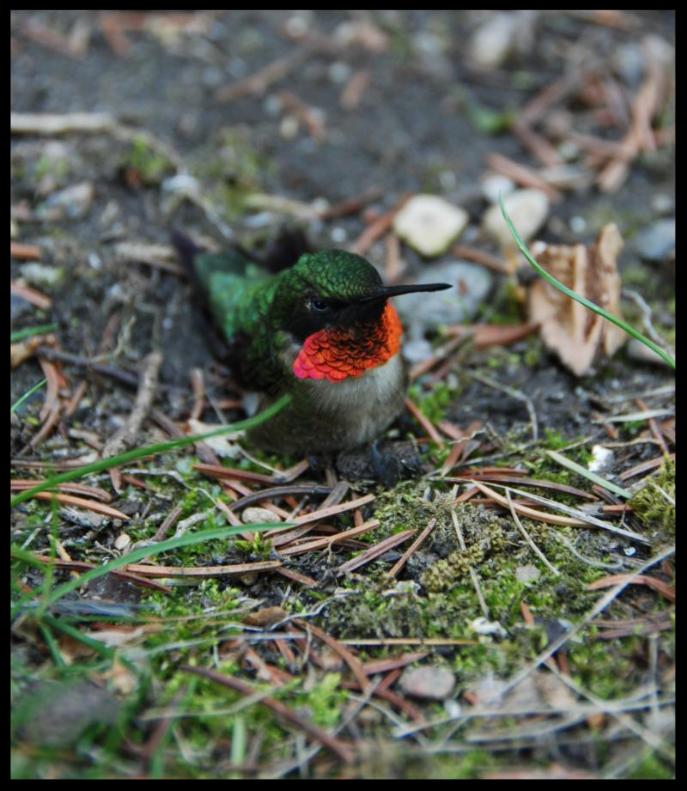 zip, zing, a green and red flash comes to check out your native plant garden. After some keen observation, you nail it down as an incredibly interesting bird species - the Ruby-throated hummingbird (
Archilochus colubris). Hummingbirds are really one of the most impressive and fascinating bird species out there. In Minnesota, this is our only resident hummingbird species. Several other species of hummingbird have been observed but are rare and are classified as "accidental visitors." The Ruby-throated is actually the only species known to reproduce in the central and eastern United States. Like many species of birds throughout the world, hummingbirds are adversely affected by climate change, habitat destruction, and predation. Want to see more of these amazing tiny little birds in your yard? Here are a few natural ways to make your property a haven for the Ruby-throated hummingbird.
|
|
 |
|
Cardinal Flower
(
Lobelia cardinalis
)
|
 |
The first and most important step to attracting hummingbirds to your yard is to introduce a variety of Minnesota native plant species. There are several species of native plants that hummingbirds go wild over. These shifty flyers are especially attracted to red or tubular flowers, where they use their long tongues to slurp up the nectar inside. Wild bergamot (
Monarda fistulosa), horsemint (
Monarda punctata), columbine (
Aquilegia canadensis), blue lobelia (
Lobelia siphilitica), butterfly milkweed (
Asclepias tuberosa), and cardinal flower (
Lobelia cardinalis) are just a few examples of native plants you might want to consider to attract these bird pollinators.

|
 |
 |

|
|
Wild bergamot
|
Horsemint (
Monarda punctata
)
|
Columbine (
Aquilegia canadensis
)
|
Blue lobelia (
Lobelia siphilitica
)
|
Native plants are more valuable than feeders
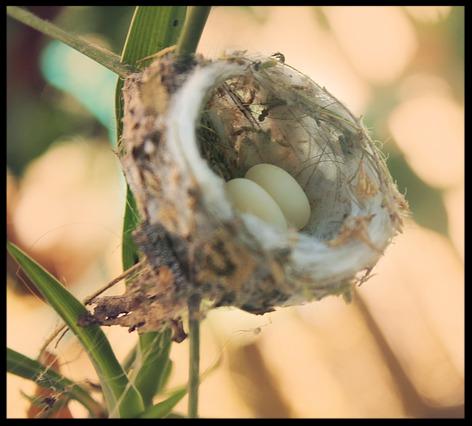 because they also provide a crucial source of protein for hummingbirds. As the hummingbirds cruise around the native plant patches, they eat a lot of small insects like gnats and flies as well as spiders and small caterpillars and worms found among native plants. Female hummingbirds feed these insects and spiders to their young while they are still in the nest. Did you know that hummingbirds also line their nests with spider silk? Although it may give you the creeps, a healthy population of spiders in our natural areas helps to form a solid ecological foundation - and our hummingbirds greatly benefit from that!
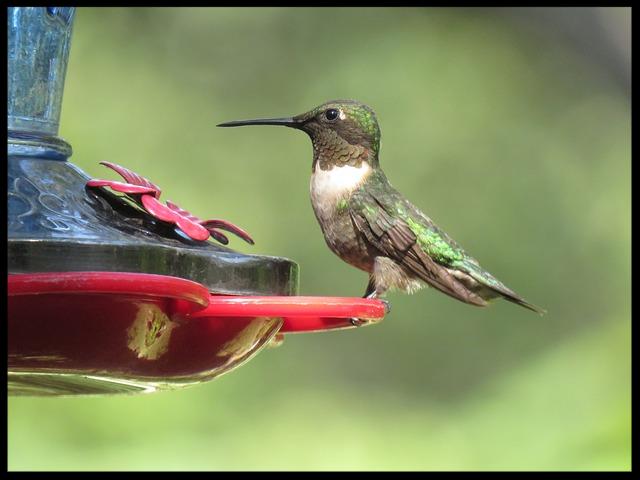 Some bird enthusiasts provide a hanging hummingbird feeder with artificial nectar - one part white sugar with four parts water (boiled for a few minutes to kill bacteria and let cool). This sugar-water in a feeder can be an important energy source for hummingbirds but it doesn't contain the nutrients that natural nectar from flowers can provide (so it's a good idea to have flowers on your property as well). It is also important to regularly clean the hummingbird feeder to prevent mold and harmful bacteria from establishing. Experts recommend cleaning the feeders every few days. Don't add red dye or other artificial colors to the sugar-water; instead get a feeder that has red colors and keep the nectar a clear color. Putting out cut fruit near the feeder can also attract some small insects that hummingbirds like to eat. If it sounds like feeders are too much of a hassle and time commitment, then it might be better to go natural and just plant more native plants!
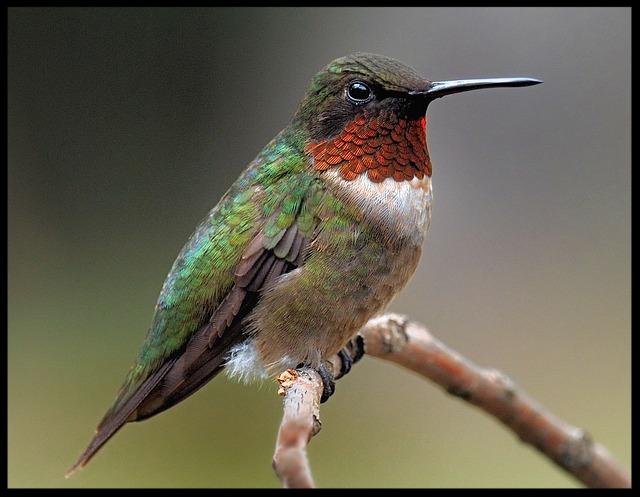
Hummingbirds nest on small branches of trees, so be careful not to over-prune your shrubs or deciduous trees. They also need safe places to perch on in order to rest, so trees and shrubs are important fixtures in a property that wants to be a haven for birds.
Another way to be involved in helping hummingbirds is to join the Audubon Society's citizen scientist program: Hummingbirds at Home. Part of this program is about documenting your hummingbird sightings. This helps researchers collect data to form a more accurate picture of how many hummingbirds are out there and their ranges.
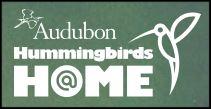
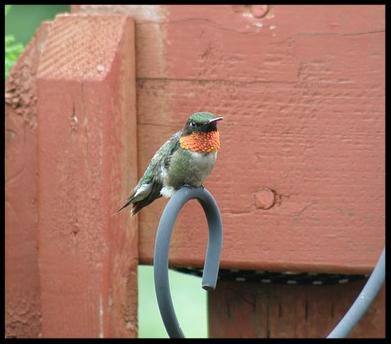 Hummingbirds usually arrive back in Minnesota around the first week of May and stay until October. During those months they need to feed almost constantly due to their fast metabolisms. Males can be very territorial so if you want to see more than one, experts recommend having different feeders and patches of native plants in both your front and back yard. These are amazing little birds that are a joy to see each season! Follow these tips and let us know if it worked on your property. Please send us pictures or post on our
Facebook page. Need native plants for attracting hummingbirds? Visit our retail nursery for perennial native plants that will attract hummingbirds year after year!
|
|
Native Plant of the Month
|
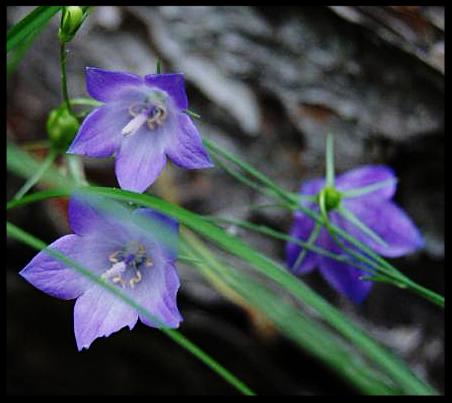
Harebell
(Campanula rotundifolia)
Moisture: Dry
Exposure: Full Sun or Partial Shade
Color: Purple
Blooms: June-September
Height: 1-1.5 Feet
Harebells might look delicate but they are deceptively tough, growing in a variety of soil conditions. They are found in woodlands and nutrient-poor areas like cliffs. They have purple bell-shaped flowers found on long thin stems.
Native Americans used the roots for medicine and the Scottish used the flowers to obtain a blue dye for their tartans. Another common name is bluebells of Scotland.
|
|
Invasive Plant of the Month
|
Creeping (European) Bellflower 
(Campanula rapunculoides)
Exposure: Full Sun or Partial Shade
Color: Purple
Blooms: June-October
Height: 1-3 Feet
Creeping Bellflower is a perennial from Eurasia that quickly spreads and dominates a landscape, out-competing native plants. It has pointy green leaves that have teeth and are bigger at the base and get smaller as they go up the stem. The stem is usually purple. Flowers are bell-shaped, purple, and slightly droop off one side of the stem. They spread both by underground root systems and seeds, with each plant producing up to 15,000 each season! Management strategies include digging out small infestations, timed herbicide treatments, and mowings to prevent the plant from forming mature seeds. Infestations can take several years to control.
|
Ruby-throated hummingbird
 |
|
 |
Photo by Carrie Mack Magnuson
|
Archilochus colubris
Range
: Eastern North America into central America
Habitat
: fields with flowers, gardens, woodland edges
Identification
:
Feathers are iridescent. Females are green and brown while males have the signature "ruby-throat" red feathers. Their beaks are long enough to reach inside flowers for nectar.
Pollination
:
Hummingbirds visit many native plants for nectar including cardinal flower, blue lobelia, columbine, foxglove beardtongue, bergamot, horsemint, and more!
|
|
|
Our retail nursery is
open
the following days:
Wed. June 13th- Sat. June 16th
Wed. June 20th- Sat. June 23rd.
Wed. June 27th-Sat. June 30th
10AM- 4PM
FREE Native Plant!
Visit us during these June dates and receive a free Purple Coneflower while supplies last!
Our retail nursery address is:
1480 County Rd. 90 Independence MN 55359
Click and visit our website for current
|
|
Long Bloomers!
Want your beautiful native flowers to last and last? Plant these flowers that have long bloom periods and enjoy!
1. Oxeye
(
Heliopsis helianthoides)
2. Hoary Vervain
(
Verbena stricta)
3. Boneset
(
Eupatorium perfoliatum)
4.Obedient Plant
(
Physostegia virginiana)
5. Culver's Root
(
Veronicastrum virginicum)
Want to learn more about these native plants? Click Here to visit our website!
|
|
Mystery Plant of the Month!
|
|
Test your plant ID skills!
Here is a popular Minnesota native plant that blooms brilliantly each summer in prairies, attracting bees and butterflies!
Need another clue?
It is a host plant for these little guys! Here is a Monarch caterpillar chomping on the Mystery Plant of the Month's leaves!
|
|
 |
|